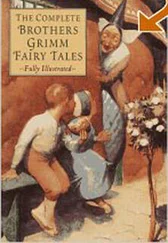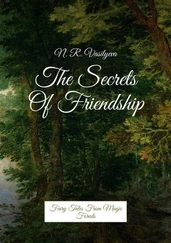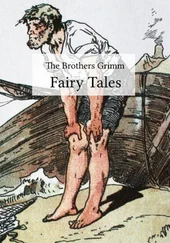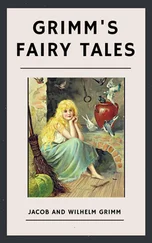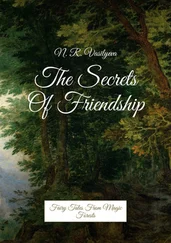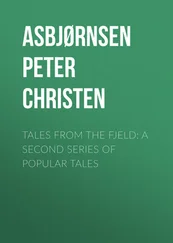When morning came they got ready to leave. The prince was already mounted on his horse when the old woman came out and said, ‘Wait a minute. Just let me give you a little drink to see you on your way.’
While she went back into the house the prince rode away, but the servant had to tighten the girth of his saddle, and he was still there when the witch came out with the drink.
‘Here you are,’ she said. ‘Take this to your master.’
But he had no time to do that, because as soon as he took it from her hand, the glass burst and the drink splashed on to his horse. It was poison, of course, and it was so strong that the poor animal fell dead at once. The servant ran after the prince and told him what had happened, and he’d have left with the prince right there and then except that he didn’t want to abandon his saddle; so he went back to get it. When he reached the dead horse, he found a raven already perching on its head and pecking out its eyes.
‘Who knows? We might find nothing better to eat today,’ he thought, so he killed the raven and took it with him.
They wandered in the woods all day long, but they couldn’t find their way out. As night fell they came to an inn, and the servant gave the raven to the innkeeper and told him to prepare it for their supper.
Now what they didn’t know was that they’d fallen into a den of brigands — murderers, in fact. And just as the prince and his servant were sitting down, twelve of these rascals turned up, meaning to do away with them, but seeing the supper arrive, the murderers thought they might as well eat first. It was the last meal they ever had, for they hadn’t swallowed more than a mouthful of the raven stew when they all fell dead. The poison in the horse had been so strong that it had passed on to the raven, and that had been enough to kill every one of them.
The innkeeper had fled, seeing what had happened, and there was no one left in the house but the innkeeper’s daughter. She was a good girl and had had nothing to do with the murderers and their wickedness. She unlocked a hidden door and showed the prince all the treasure they’d stolen: piles of gold and silver, and mounds of jewels. The prince said she should keep it for herself: he wanted nothing to do with it.
And once again he and his servant rode on their way.
They travelled about for a long time, and one day they came to a town where there was a princess who was both very beautiful and very proud. She had announced that she would marry any man who asked her a riddle that she couldn’t solve. However, if she managed to solve it to the satisfaction of twelve wise riddle-masters, his head would be cut off. She would have three days to think about it, but she was so clever that she always solved it long before that time was up. Already nine men had tried to beat her, but each of them had lost his head.
However, that didn’t worry the prince; he was so dazzled by her great beauty that he was willing to risk his life. He went to the palace and asked his riddle.
‘One killed none,’ he said, ‘but still killed twelve. What is it?’
She had no idea what it could be. She thought and thought, but nothing came to mind. She consulted all her riddle books, but there had been nothing like it in all the history of riddles. It seemed as if she’d met her match at last.
However, she wasn’t willing to give up, so that night she sent her chambermaid to creep quietly into the prince’s bedroom. There she had to listen carefully to anything he said in his sleep, in case he revealed the answer to the riddle in his dreams. But that came to nothing, because the prince’s servant had taken his place, and when the maid came in he snatched away the robe she’d covered herself with, and chased her away with a stick. So that didn’t work.
On the second night she sent another maid, to see if she’d be any more successful. His servant took her robe as well, and chased her away with an even bigger stick. So that didn’t work either.
On the third night the prince decided to wait and watch himself. This time the princess came herself. She was wearing a beautiful mist-grey robe, and she sat down softly on the bed next to him and waited till she was sure he was asleep.
But he was still awake, and when she whispered, ‘One killed none. What is that?’ he answered, ‘A raven ate the flesh of a horse that was poisoned, and died itself.’
Then she said, ‘But still killed twelve. What does that mean?’
He answered, ‘Twelve murderers ate a stew made from the raven, and died of it.’
She was sure she had the answer now, and she tried to tiptoe away, but the prince caught hold of her robe and held it so tight that she had to leave it behind.
Next morning the princess announced that she had solved the riddle. She sent for the twelve riddle-masters and told them what it meant. It looked as if the prince was doomed, but he asked to be heard.
‘The princess came into my room when she thought I was asleep,’ he said, ‘and asked me what the answer was. She would never have guessed it otherwise.’
The riddle-masters conferred together and said, ‘Have you any proof?’
Then the prince’s servant brought in the three robes. When the riddle-masters saw the mist-grey one which no one but the princess ever wore, they said, ‘Have this robe embroidered with gold and silver, your highness, for it will be your wedding gown. The young man has won!’
* * *
Tale type:ATU 851, ‘The Princess Who Cannot Solve the Riddle’
Source:a story told to the Grimm brothers by Dorothea Viehmann
Similar stories:Alexander Afanasyev: ‘The Princess Who Wanted to Solve Riddles’ ( Russian Fairy Tales ); Katharine M. Briggs: ‘The Young Prince’ ( Folk Tales of Britain ); Italo Calvino: ‘The Son of the Merchant from Milan’ ( Italian Folktales )
This is a widely distributed tale type, a variation of it turning up, for example, in Puccini’s opera Turandot of 1926. The Grimms’ version is much better than most, not least for its neatness and the clarity of the three-part structure. Neatness and clarity are great virtues when you’re telling a story. The Grimms’ source for this story was Dorothea Viehmann, a fruit-seller from Zwehrn, not far from Kassel where the Grimm brothers lived. She provided several tales for them, a number of which appear in this collection, and had the unusual ability not only to tell a story vividly and fluently, but then to go back and repeat it phrase by phrase so they could take it down accurately. The brothers paid tribute to her in the preface to their first edition:
Those who believe that oral narratives are routinely falsified, that they are not carefully preserved, and that long recitations are, as a rule, impossible, should have the chance to hear how precisely she stays with each story and how keen she is to narrate correctly; when she retells something, she never changes its substance and corrects an error as soon as she notices it, even if it means interrupting herself.
(Quoted in translation by Maria Tatar in The Hard Facts of the Grimms’ Fairy Tales )
FIFTEEN
THE MOUSE, THE BIRD AND THE SAUSAGE
A mouse, a bird and a sausage decided to set up home together. For a long time they carried on happily, living within their means and even managing to save a little. The bird’s job was to go into the forest every day and bring back wood for the fire, the mouse had to get water from the well, make the fire and lay the table, and the sausage did the cooking.
But we’re never content with living well if we think we can live better. One day, as the bird was in the forest, he met another bird and boasted about his pleasant way of life. The other bird only called him a poor dupe.
Читать дальше

